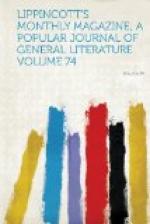[Illustration: FORTRESS OF RIVA, AND THE BLACK SEA.]
Returning to Constantinople, our steamer ran close to the European shore, stopping at the villages on that side. Most of the officers of these boats are Turks, but they find it necessary to employ European (generally English) engineers, as the Turks are fatalists and not reliable. It is said they pay but little attention to their machinery and boilers, reasoning that if it is the will of Allah that the boiler blow up, it will certainly do so; if not, all will go right, and why trouble one’s self? Laughable stories are told of the Turkish navy; e.g., that a certain captain was ordered to take his vessel to Crete, and after cruising about some time returned, not being able to find the island. Another captain stopped an English vessel one fine day to ask where he was, as he had lost his reckoning, although the weather had been perfectly clear for some time. In the Golden Horn lies an old four-decker which during the Crimean war was run broadside under a formidable battery by her awkward crew, who were unable to manage her, and began in their fright to jump overboard. A French tugboat went to the rescue and towed her off.
On our way to the hotel we saw the sultan’s son, a boy of fifteen. He was driving in a fine open carriage drawn by a very handsome span of bay horses, and preceded by four outriders mounted on fine Arabian horses. Coachman, footman and outriders, in the black livery of the sultan, were resplendent in gold lace. The harness was of red leather and the carriage painted of the same bright color. The cushions were of white silk embroidered with scarlet flowers. It was a dashing equipage, but seemed better suited to a harem beauty than the dark, Jewish-looking boy in the awkward uniform of a Turkish general who was its sole occupant.
[Illustration: TURKISH QUARTER—STAMBOUL.]
Yesterday we took our last stroll in Constantinople, crossing the Golden Horn by the new bridge to Stamboul. This bridge is a busy spot, for besides the constant throngs that cross and recross, it is the favorite resort of beggars and dealers in small wares. Many of the ferryboats also start from here, so that, although long and wide, it is crowded most of the day. An Englishman who is an officer in the Turkish army told us of an amusing adventure of his in crossing




